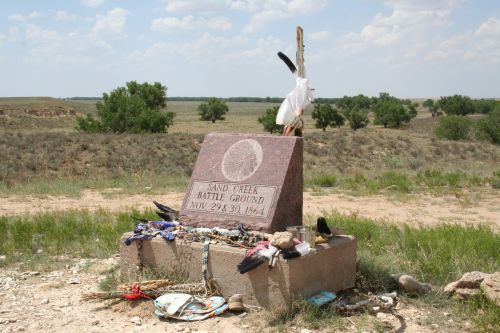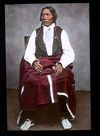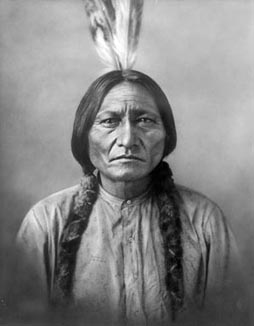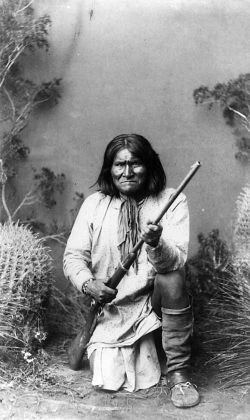NATIVE AMERICAN GENOCIDE
NATIVE AMERICAN GENOCIDE
1850 eleven Indian reservations were created in Quebec
Helen Hunt Jackson wrote in 1881 A century of dishonor.
Premiums are paid for scalps in both New France and New Angleterre.Les Indians defend their territories against the passage of the railway.
In Kentuckyvid Crockett and Daniel Boone hunted the Shawnee. Chief Tecumseh was allied with the British against the Americans in 1812
Little Crow
1862: The Sioux Little Crow in Minnesota hunting Americans. They kill 500
1800 Sioux are taken prisoner.
Public hanging of 39 leaders in Mankato on December 26.
The government put a price on the Tet Little Crow.
1862-1864: After the suppression of the revolt of Minnesota, the army continues its war against the Sioux of the East and pushes them to the West.
Chief Mangas Coloradas
1862: The Chiricahua Apaches and Mimbreños under the orders of their chief Mangas Coloradas and Cochise quit in July in advance of white on the ground Apache.
1863: July 3, Little Crow was killed by a shot by a farmer, when he fled before the American troops.
In New Mexico, California volunteers treacherously murdered the chief Mangas Coloradas.
Sand Creek
1864: The Navaho, holed up in the Canyon de Chelly, heroically defending themselves against U.S. troops, but can not escape deportation in desert regions.
The Sand Creek encampment of peaceful Cheyenne South with their chief Black Kettle was attacked Nov. 29 by the regiment of Colonel JMChivington.
Colonel J.M.Chivington
The Indians were massacred by soldiers engaged in the worst atrocities.
1864: Sand Creek Massacre in Colorado: 600 Cheyenne were killed.
1865: Punitive Expedition army against the Arapaho near Powder River.
Red Cloud
1866: Red Cloud destroys a detachment, Commanded by Captain Fetterman, of the garrison at Fort Kearny, December 21.
1868: The Black Kettle of the Cheyennes were defeated by the Regiment of Custer.
Custer
November 27, 1868, four years after the massacre at Sand Creek, Custer's troops attacked the village of Black Kettle, this time the chief and his wife lost their lives at Washita. The Washita Massacre was not a victory for Custer. He killed 130 Cheyenne and Arapaho Indians on the field, as well as 20 civilians, among them there were a dozen real fighters, the rest were non-combatants, he made 53 prisoners and 800 horses abbat, and releases three hostages white (a woman and two children) in a camp of 50 teepees located on the Washita River (Oklahoma).
General Sherman exterminated the buffalo to starve the Dakota Sioux and deport them on reserve.
The extermination of the bison was commissioned in Buffalo Bill, Wyatt Earp and many others, to feed the workers of the railway under construction, satisfy the need of skins in Europe, gluttony for Languages and bison. .. to starve the Plains Indians.
After the defeat of the Confederates, General Sherman received the surrender of Sitting Bull in 1881. The steps of this genocide were the massacre Chivington, Colorado (1864), the massacre of Fetterman (Wyoming, 1866) and the Battle of Little Big Horn (Montana, 1876).
there was, in 1862, about 9 and a half million buffalo on the plains between the Missouri and the Rocky Mountains. All are gone, killed for their meat, their skin and bones .... On that same date, there were about 165,000 Pawnees, Sioux, Cheyennes, Kiowas and Apaches, whose diet depended on the annual buffalo.
Cochise
1874: Death of Apache Chief Cochise on 8 juin.Regain struggles against the Apaches in Arizona and New Mexique.Les Plains Indians and prairie are fighting fiercely to oppose the slaughter of bison.
June 27, the Comanche chief Quanah's orders, attacked a camp of buffalo hunters in Abobe Walls (Texas).
The superiority of firearms whites are forced to fight in retraitre.
Shamefully flouting the Fort Laramie Treaty concluded in 1868, the 7th Cavalry Regiment, commanded by Lieutenant Colonel Custer, Black Hills occupies.
Sitting Bull, chief of the Sioux Tetons Hunkpapas, fanning the flame of resistance among the Sioux, Cheyenne and Arapaho.

1870: On the advice of Sitting Bull (pictured right) and Crazy Horse (Left photo) The Sioux and Cheyennes come together and they break up the army at Little Big Horn: 285 U.S. soldiers are killed.
The valley of the Little Bighorn River (little sheep) in Montana was the site of a battle June 26, 1876 that pitted the Lakota and Cheyenne Indians commanded by Lakota Indian Chief Sitting Bull (1831-1890) and American soldiers commanded by General Custer (1839-1876).
The greatest victory of the Indians
Again called Custer National Battlefield, the Little Bighorn Battlefield National Monument is the symbol of courage and bravery of the Indians. Here occurred one of the biggest battles between Indians and settlers.
On 25 June 1876, the 7th Cavalry led by General Custer terrible and impetuous rushes into a trap. After terrorizing the native population of Native Americans, Custer sent his troops without imagining that the Sioux and Cheyenne tribes joined forces to counter the offensive.
That day, 2,000 Indian warriors led by chiefs Sitting Bull and Crazy Horse annihilate the 7th Cavalry Regiment and end the cruelties of General Custer.
This time, the Indians have the last word.
But this Indian uprising is one of the last. The massacre of some settlers unworthy the public while still being insensitive to the massacre of an Indian village where reside only women and children. The U.S. military rule definitively the problem by wiping out the latest Indian forces.
Anyway, the Little Big Horn Battlefield National Monument, you can visit the battlefield and the cemetery where lie the 263 soldiers killed. In the town of Garryowen on Custer Battlefield Museum will allow you to enter the course of the bout.
Finally, enjoy your visit to admire the scenery of Montana. We understand why the Indians were so attached to their region ...
Little Bighorn Battlefield NM is located in Montana, about 100 miles northeast of Cody.
1877: The Northern Cheyenne, the orders of Dull Knife and Little Wolf, surrendered and were deported on May 1 in Oklahoma where they have to walk.
1877: War of the Nez Perce in Montana and Idaho.
1880: All the tribes were placed on reserve.
Buffalo Bill had been a rider for the delivery of mail in the Pony Express. He was also conductor of convoys of cattle that were destined for the Chicago stockyards.
1882: Buffalo Bill cashes his art with his lasso "Wilde West Show." His band included one hundred Rough Riders and Indian bison and elk was transported to Paris. In 1886 Little Annie, an artist of the gun joined the troupe.
That same year the show was presented in Pointe-St-Charles, Quebec. Buffalo Bill died in 1917.
Geronimo
1885: The surrender of Geronimo ended the war apache who led guerrilla operations in New Mexico from 1862 to 1872. He was deported to a reservation in Oklahoma.
1890: Sitting Bull, the Sioux chief fled to Canada before being murdered by Americans Standing Rock Dec. 15 - as was also Crazy Horse.
On December 15, 1890, forty Indian police officers entered the house Sitting Bull, the Standing Rock Sioux reservation. He refused to follow them. A scuffle ensued, in which the necks of a shot rang out, Sitting Bull fell dead, then the panic seized the other Sioux, thinking that the army would carry out reprisals against them. They fled en masse from the reserve, however, some of the fugitives rejoined after a few days. The others joined Big Foot, whose arrest was also planned. But he left his reserves before we pick him with four hundred other Indians, in order to earn Pine Ridge where was Red Cloud.
Bigfoot
Women screamed, children clinging to their robes, crying, everyone fell under the fire of white men. This is the end of the Indian wars. While 25 soldiers killed are buried with honor, the Sioux dead were thrown into a mass grave. One witness said a woman lying in his blood had her baby she was suckling her breast. Up to 2 km were found the bodies of those who tried to escape their tormentors.
Wounded Knee 1890
THE MASSACRE AT WOUNDED KNEE
Narrated by Mathew King, nephew of Red Cloud:
Big Foot's people had done nothing wrong. It was the heart of winter. The Minniconjous came from North Dakota to take refuge at Pine Ridge along with Red Cloud. They were cold. They were hungry. Their only goal was to survive. They followed the precept of God.
The band set up camp at Wounded Knee. The soldiers arrived with their guns. They surrounded Big Foot and his people as if they were criminals, in fact, especially where there were old men, women and small children. Big Foot does not want to fight. He was already suffering from pneumonia. It was peaceful.
The soldiers line up the Indians in the cold and withdrew all their weapons. One of the last men in the queue, Yellow Bird, bullied by a soldier raised his rifle and fired point-blank in the head of the American. Those who managed to escape told all this to our people.
The soldiers stationed at the top of the hill then opened fire and spared no one. The Indians collapsed to the ground and soldiers mowed two dozen of them, The warriors tried to defend their people. They fought with all their energy but they had no chance. The soldiers massacred them, then massacred the old men, women and children.
Where is he said he must punish the whole family, the whole people for the misdeeds of one man? Is this your justice? Is this what your Constitution says? This is not what we teach God's Law.
They massacred three hundred of us.
Our blood conferred its sanctity at Wounded Knee.
December 29, 1890
The army surrounded the camp of Big Foot and installs Hotchkiss guns. The head, extremely low stirred little white flag he had hanging from his stretcher. The army ordered the Indians to surrender their weapons, and come together while the soldiers searched the camps showing great harshness against the Lakota. The Big Foot Miniconjus obtempèrent. Who fired the first shot that sparked the shooting, no one knows, but one shot left.
Immediately, the army fired indiscriminately at the 300 female children and the elderly. Women were screaming trying to escape the fire, the children clinging to the skirts of their mother crying, not longtemps.Puis cease fire, there is silence, it vaporizes: about 300 corpses, including that of Big Foot litter the ground.
The fury of the army was such that the bodies of women trying to escape their tormentors were found just 2 km from Wounded Knee. For their part, soldiers killed dénombrent twenty five and thirty nine wounded. An investigation revealed that the losses suffered by U.S. forces was the fact of their own weapons.
On January 3, 1891 The bodies were thrown into a mass grave without further formalities.
Wounded Knee.
1890: There are only 50,000 Indians when they were 850,000 before the arrival of whites. Children were abducted and headed families in boarding schools to educate them.
Inscrivez-vous au site
Soyez prévenu par email des prochaines mises à jour
Rejoignez les 76 autres membres
